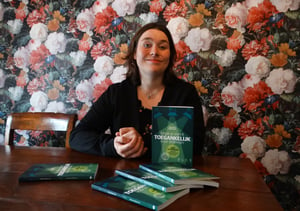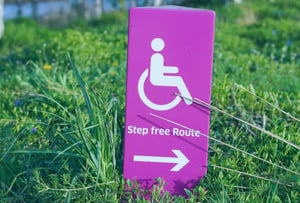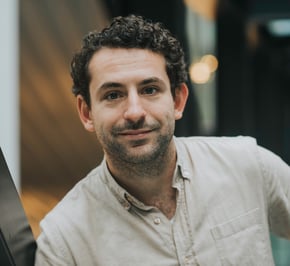As a leisure management student at the Rotterdam University of Applied Sciences, Marianne Dijkshoorn discovered what accessibility means in practice. Dijkshoorn has reduced mobility herself, and when she experienced how bad the accessibility of Rottepop festival was, she was bold enough to approach the organisation of the festival. The organisation took her feedback seriously and asked her for advice. Nowadays, Dijkshoorn advises numerous organisations on how to organise events and locations as the founder of Welkom Toegankelijkheid & Evenementen [welcome accessibility & events] and organises (accessible) events herself. She shares six tips to make events accessible to people with a disability.
Economic motive
One in eight Dutch people has a (physical) disability: think wheelchair users, people with bad hearing or people with a poorly functioning arm. Dijkshoorn: “If we add chronically ill people, such as people with chronic fatigue, the total comes down to one in six Dutch people. Accessibility therefore can be an economic motive as well.”
Accessible events pay off
Dijkshoorn indicates that many event locations call themselves accessible because they have a disabled toilet. A disabled toilet is important for wheelchair users, but this alone does not guarantee an accessible event. In the UN Convention on the Rights of Persons with Disabilities, signed by the Netherlands as well, the participating countries agreed to strive for accessibility for everyone.
Dijkshoorn: “Wheelchair users can’t get into cafes, service dogs are often not allowed in venues and people with special needs are forced to watch events from the sidelines. But there are alternatives. The Van Nelle Fabriek [a large event location] in Rotterdam, for example, clearly states on the website what they do for people with a disability. They offer a bowl of water for service dogs and create a room to rest if there is a demand for it. As a result, they received a quality mark. By clearly communicating what you do for people with a disability, more people with a disability will come to your event or location. Location owners get more bookings, because many companies are looking for accessible locations.”
The Dutch Participation Act has ensured that more people with disabilities can work for regular organisations. These employees attend the annual congress and other employee events. The government now demands that organisations welcome everyone. Investments in accessible event locations and organisations are therefore worthwhile.
6 tips to make your events more accessible

Dijkshoorn, author of the book Maak je event toegankelijk voor iedereen [Make your event accessible for everyone], shares six tips for improving the accessibility of events, for both organisations and locations.
- Tip 1: Investigate accessibility requirements in advance
“Many event organisers wonder how many people with disabilities to expect. Blind attendees wish to receive the presentations in advance, so they can use reading software to gather the information, wheelchair users require a disabled toilet and people with a hearing impairment need subtitled videos. The registration form can offer a solution. Besides inquiring about dietary preferences, you can ask about the visitors’ accessibility needs. This makes it possible to deliver customised solutions to really make a difference.” - Tip 2: Have everyone participate in the event
“Facilitate that all attendees can really participate in your event. Ensure that they all can have the same shared experience. Placing wheelchair users or people with service dogs next to or in the aisles is not a good option, since they are blocking the passage. There’s a simple solution to this: just remove a chair and use this spot for the aid, such as a wheelchair, service dog, etc.” - Tip 3: Communicate the policy to the staff
“Some locations refuse access to a service dog. Without their dog, the (blind) boss will not enter. It’s that simple. Every time I hear someone say “no” to a disabled person, my heart breaks. The staff can really make the difference. If somebody is willing to carry a cup of coffee for people with limited mobility, they make that person’s day a lot easier. It is important for organisations to communicate their policy to the entire organisation.” - Tip 4: Make networking possible for everyone
“At most networking occasions, standing tables are part of the default setting. Why not place some seats for people with limited mobility or for those who get tired easily? Providing variation in the setting will make networking possible for everyone.”
- Tip 5: Communicate directly with disabled attendees
“I once visited a festival where my wheelchair could not pass through the normal exit, because the exit was very narrow. Due to inadequate communication between security, they did not offer me any other exit. At another event they put me in the first aid tent during a storm. The employees had no idea how to get me off the site. I was able to walk a short distance, which would have been an easy solution to the situation. But they didn’t know, because they did not include me in the conversation. Talking to a person, instead of about them is always the best option.”
- Tip 6: Check the disabled toilet at every location visit
“Many locations offer a disabled toilet. However, these toilets are often used for storage or unsuitable for wheelchair users because of improper arrangements. That is inconvenient: imagine a conference where you can not use the restroom all day. If you – as an event professional – visit a location, make it a habit to check the disabled toilet - and make sure there is an empty square meter next to the toilet to park a wheelchair. Wheelchair users pull themselves up to the toilet by using the grab bars.”
Conclusion
Events are about the total experience of all attendees. Organisations that focus on accessibility can reach even more guests - and they contribute to the total satisfaction of attendees when disabled people are taken into account. As a result, their attendance rate will increase and they contribute to a pleasant experience for all guests and a positive outset on the event or brand. This makes investing in accessible events economically viable as well.

